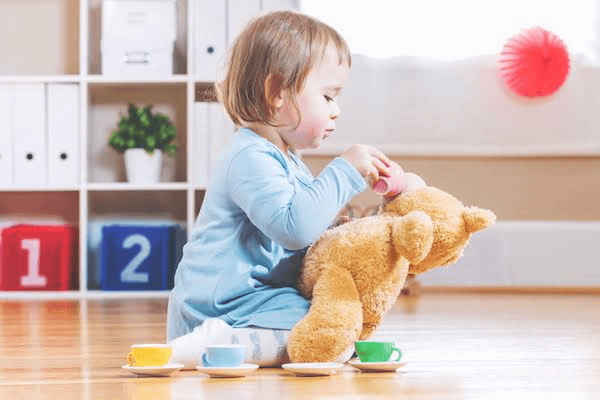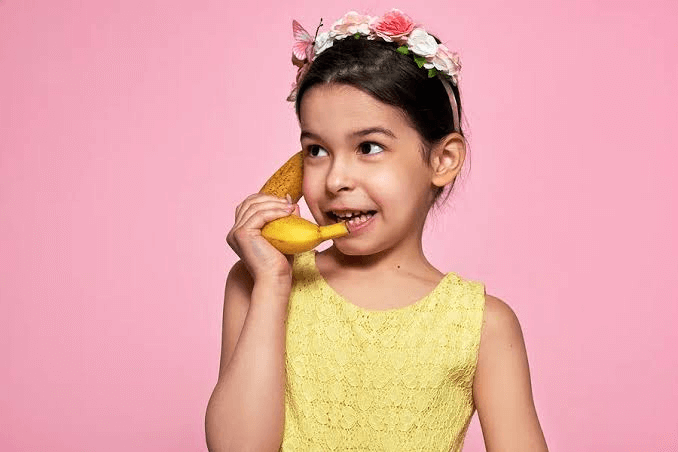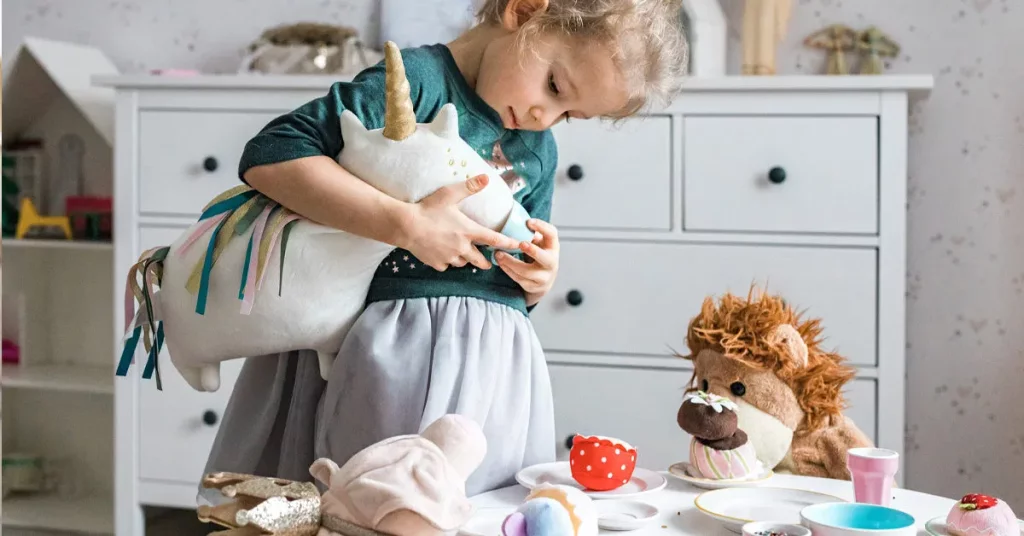You might have often observed your children engrossed in their imaginative world while playing with toys; they will give each stuffed animal a role and even sometimes amaze you.
Well, this is quite normal; your baby is learning and having fun while adapting to this world, and this is symbolic play.
It is quite normal to have various questions regarding it, like if this is appropriate or the right age to do it. Or you may even be worried even if the child is not into it.
For a fuller picture, See how this topic connects with our last discussion in our previous blog post on symbolic trees.
So we are here to talk about everything related to symbolic play, at what age it develops, and how important it is.
Let’s dive right in.
What is Symbolic Play?

Symbolic play is a form of imaginative play where your child uses one thing as a symbol to represent something else.
This is symbolic play when you see your children picking up an abandoned box and making a ship out of it while pretending to be a pirate or using random objects as mobile phones while babbling on it.
When Does Symbolic Play Emerge?
Symbolic play emerges from the age of three months and keeps developing till age 5, but kindly remember that each child has their own pace.
We can roughly divide these stages into three categories according to age.
1. Early Days – Up to 18 Months Old

From the day your child enters the world, he starts learning new things by observing everyone and everything around him. Until 18 months, a child gets engaged in pre-symbolic or functional play. Functional play is when the child starts using objects out of their context.
They will pretend to drink from an empty glass; later, it will develop with age, and you can observe a change in pattern like they will start making vroom sounds while playing with a car.
2. Toddlers Play- 18 Months to 3 Years

Language explosion happens at this age when the symbolic play takes off. They start using words to build up their thoughts and imagination. Children will love playing alone with their toys or some random objects at this age.
You will notice that they have started using random objects as mobile phones and even started talking to pretend people. Children copy elders’ actions by observing them act like them alone, and they may also start including other stuffed toys in play.
3. Preschoolers- 3 Years to 5 Years

At this age, symbolic play starts evolving, and the child starts engaging in associative play, where they play along with other kids by assigning roles and making plans about where the play will start and how it will end.
For example, your child will try to feed the baby doll with the spoon, the doll will be the baby, and they will pretend to act like their mom or dad, or they will pick up an abandoned box and make a rocket ship out of it.
Why is Symbolic Play Important?
Symbolic play is very important for the growth and development of your child. This may look cute and fun to watch, but there is a lot more your child is learning through it.
So, if you are worried about your child talking to herself, please don’t be. They are learning and developing practical knowledge about this world through symbolic play.
Skills Your Child Can Develop with Symbolic Play

1. Cognitive Skills
Symbolic play is all about acting out on imaginations in creative ways. This way, they are developing their creative and problem-solving skill.
When they act out the situation, their past experiences play a role in understanding the consequences better. Their brain gets hardwired on how to act under what situation and how to solve it.
2. Social Skills
The child may engage with others and include them in the play, or they will involve their toys and pretend they are real by assigning them roles. But in both these situations, your child is considering the thoughts and feelings of someone else than just herself.
Your child will learn to cooperate with others, empathize with them, and develop the skill of negotiating with symbolic play.
3. Language
Symbolic play is a great medium to develop vocabulary. You may notice that they have picked up various terms and words by observing people, feeding them in their memory, and then using them while playing, and this is the foundation of language acquisition.
So, you should also be aware of the words you speak while interacting with or around your child.
4. Motor Skills
Playing involves a lot of action. When your child gets involved in any activity, they develop gross and fine motor skills simultaneously.
At an early age, it is more about the gross motor, and then as they grow older, the fine motor skills develop, like braiding the doll’s hair, counting the number of pillows, or picking up the beads. You will hear them say, “You stand last in the line,” or will pretend to cook with their kitchen set.
All of these help develop motor skills.
Conclusion
The point is to let your child be. Do not restrict them as that may restrict their imagination. This is an imaginative play; it should have no limitation, boundary, or rule. Your child can be whatever he wishes to be and play with the most random things to create their imaginative world.
Please do not compare your child or worry if your child is not getting as involved in symbolic play. Every child has their own pace, and you cannot do anything about it.
So relax and let them bloom in their beautiful way.

